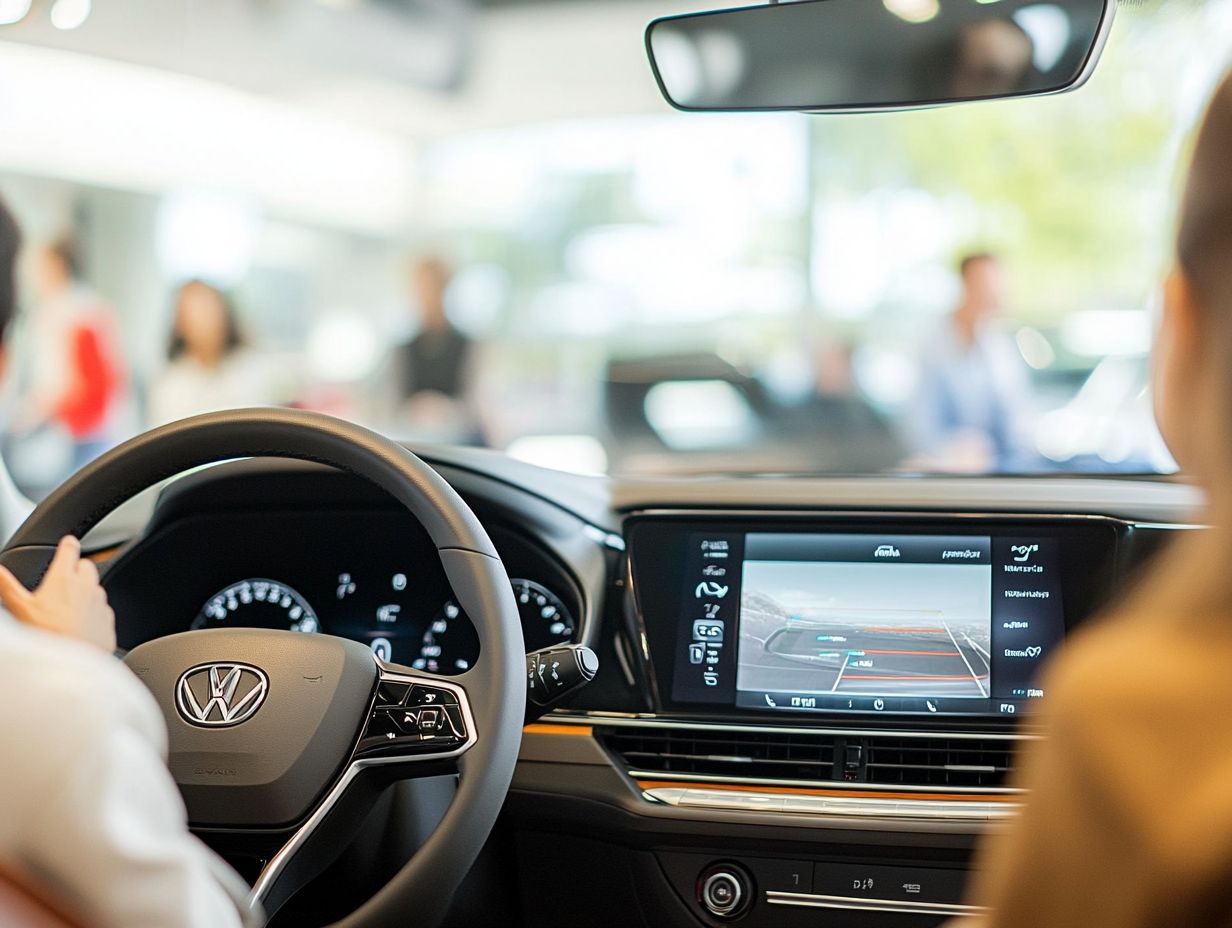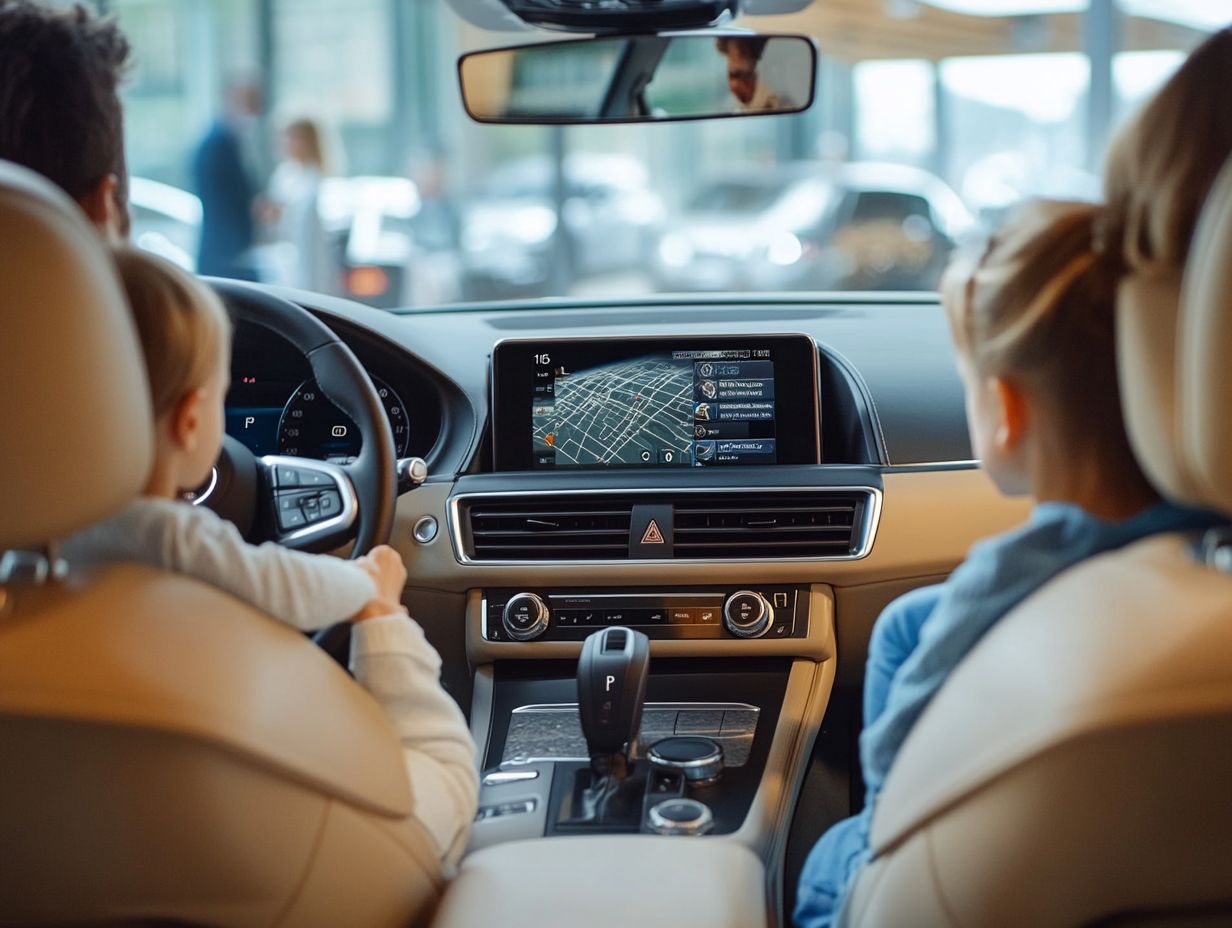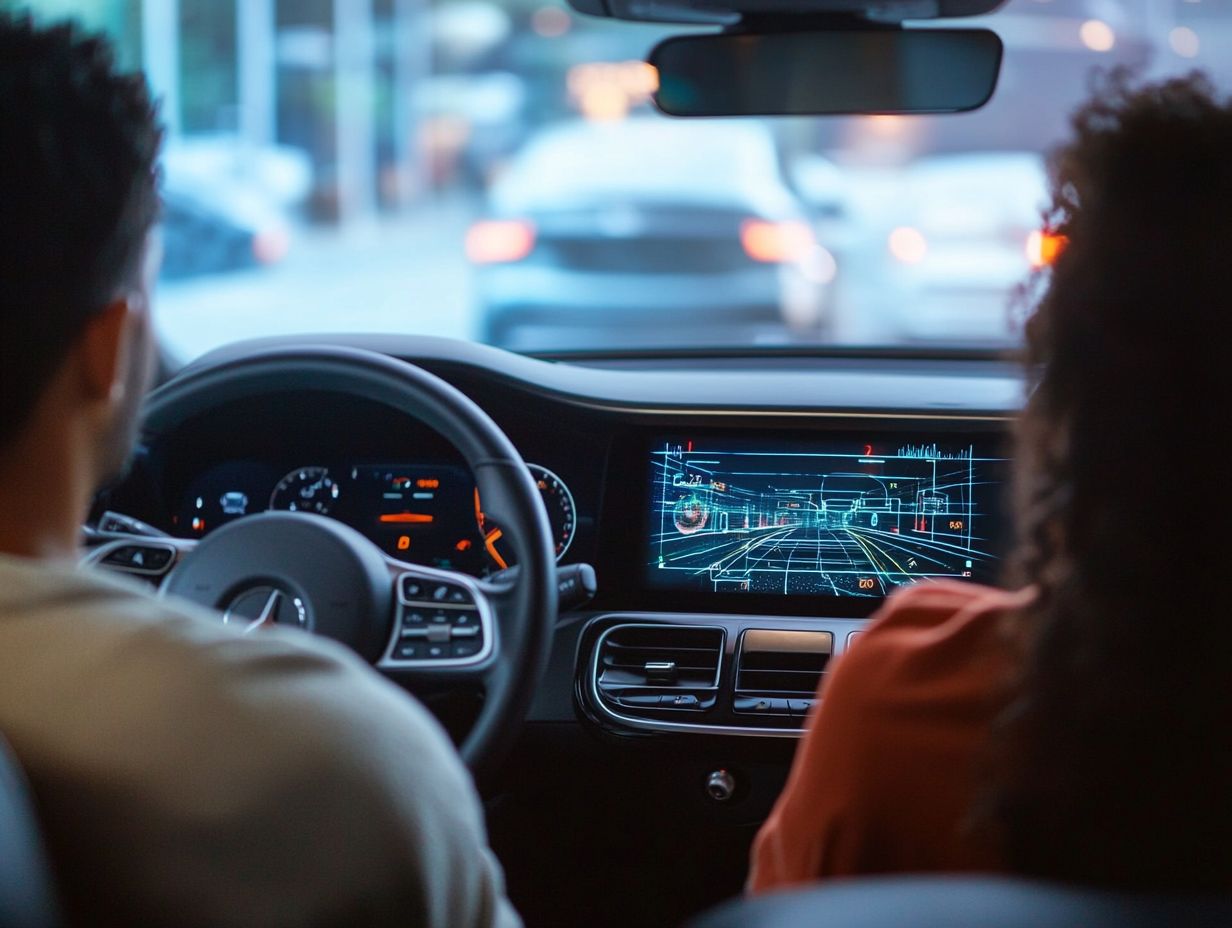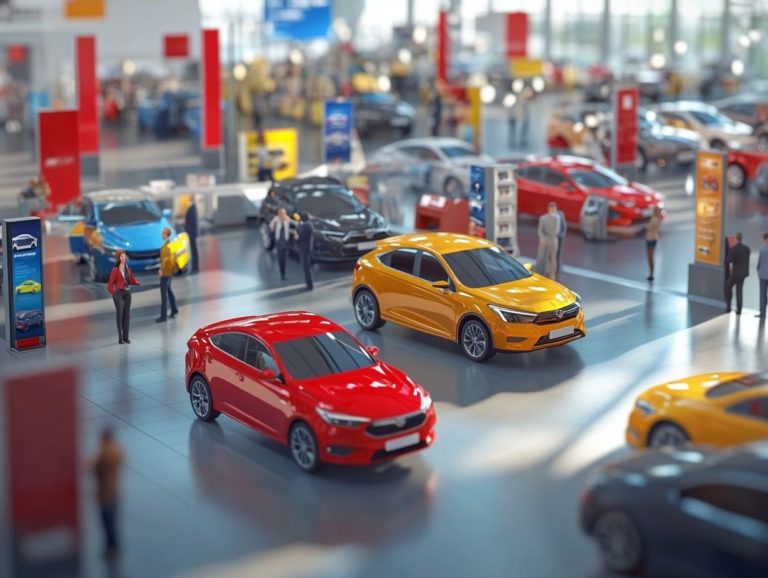5 Safety Features Every New Car Should Have
When you set out to shop for a new car, prioritizing safety should be at the forefront of your mind. With the rapid advancements in technology, today’s vehicles boast a variety of safety features specifically designed to protect both drivers and passengers.
In this exploration, you ll discover five essential safety features that every car should possess, such as airbags, anti-lock brakes, and electronic stability control.
Get ready to make informed choices for your next vehicle! Don t wait! Understanding these features can significantly impact your safety on the road.
Contents
- Key Takeaways:
- 1. Airbags
- 2. Anti-Lock Brakes (ABS)
- 3. Electronic Stability Control (ESC)
- 4. Blind Spot Monitoring
- 5. Rearview Camera
- What Are the Most Important Safety Features in a Car?
- Frequently Asked Questions
- What are the 5 safety features every new car should have?
- Why is a rearview camera important in a new car?
- What is automatic emergency braking and why is it crucial in new cars?
- How does lane departure warning help improve driving safety in new cars?
- Why is blind spot detection an essential safety feature in new cars?
- How do airbags enhance the safety of new cars?
Key Takeaways:

- Airbags, anti-lock brakes (ABS), electronic stability control (ESC), blind spot monitoring, and rearview cameras are essential safety features that all new cars should have.
- These safety features provide many benefits, such as reducing the risk of injury and accidents. They utilize advanced technology to detect and prevent potential hazards on the road.
1. Airbags
Airbags are vital car safety features crafted to protect you during vehicle accidents. When a collision occurs, they deploy rapidly, offering you a crucial shield. Their effectiveness has been validated by respected organizations like the Insurance Institute for Highway Safety (IIHS) and the National Highway Traffic Safety Administration (NHTSA).
These life-saving devices come in various types frontal airbags, side-impact airbags, and curtain airbags each strategically positioned within your vehicle for optimal protection. Frontal airbags deploy from the steering wheel and dashboard, while side-impact airbags are located in the seats or door panels, ready to cushion you in the event of a side collision.
Research shows that airbags can reduce the risk of fatal injuries by approximately 29% in frontal crashes. Recent advancements in airbag technology have introduced features such as adaptive airbags, which are airbags that adjust their deployment based on passenger size and position, enhancing your safety even further.
With vehicles now boasting high safety ratings thanks to these innovations, you, as a consumer, are becoming increasingly aware of the essential role airbags play in modern vehicle design.
2. Anti-Lock Brakes (ABS)
Anti-lock braking systems (ABS) are vital car safety technologies designed to prevent wheel lock-up during intense braking. This significantly elevates your vehicle control and safety during emergency stops.
By leveraging an intricate network of sensors, ABS continuously tracks the speed of each wheel, allowing the system to adjust brake pressure as necessary. This feature works harmoniously with traction control systems, which help curb wheel spin when accelerating on slick surfaces, offering you a smooth and confident driving experience.
Together, these technologies effectively shorten stopping distances, particularly in challenging weather conditions like rain or snow, where losing traction can lead to perilous scenarios. Importantly, a range of automotive regulations worldwide now require the inclusion of ABS in new vehicle models, ensuring the utmost safety for both drivers and passengers.
3. Electronic Stability Control (ESC)
Electronic Stability Control (ESC) is a revolutionary driver assistance system designed to significantly reduce the risk of skidding and loss of control, especially during challenging driving conditions. It s a game-changer for vehicle safety and stability.
This advanced technology operates by continuously monitoring your vehicle’s traction and directional stability. When it senses a potential skid, it automatically applies brakes to individual wheels, helping to guide your vehicle back on course.
Such timely intervention is essential for enhancing overall road safety, particularly in adverse weather conditions or during sudden maneuvers. Acknowledging its life-saving capabilities, numerous countries have made ESC a mandatory feature in new vehicles, integrating it into their automotive regulations.
This widespread adoption highlights the critical role ESC plays in preventing accidents and safeguarding both drivers and passengers.
4. Blind Spot Monitoring

Blind-spot monitoring systems are essential safety technologies that alert you to cars you can’t see, thereby enhancing your overall awareness and significantly reducing the risk of accidents while you re on the highway.
These sophisticated systems employ a blend of radar, cameras, and ultrasonic sensors positioned around your vehicle to detect nearby cars that standard mirrors might miss. When a vehicle encroaches on this crucial zone, you receive visual or auditory alerts often indicated by lights on the side mirrors or a warning sound.
Blind-spot monitoring also works well with other advanced safety features, such as lane departure warnings and automatic emergency braking, creating a comprehensive safety network. This integration greatly lowers the chances of collisions, keeping you better informed and giving you the power to make safer lane changes.
5. Rearview Camera
Rearview cameras have become essential safety features in modern vehicles, offering you a clear view of the area behind your car. This enhancement not only boosts collision detection but also significantly minimizes the risk of accidents while you’re reversing.
These cameras utilize wide-angle lenses to capture an expansive visual field, relaying real-time images directly to your dashboard display. Regulations set by the National Highway Traffic Safety Administration (NHTSA) now require that all new vehicles come equipped with these systems, recognizing their vital role in enhancing driver awareness.
Studies show that rearview cameras reduce backing accidents by up to 30%, which includes a notable decline in incidents involving pedestrians, especially children. By providing you with a clearer perception of your immediate surroundings, these safety features are instrumental in preventing accidents and elevating overall road safety.
What Are the Most Important Safety Features in a Car?
In today’s rapidly evolving automotive landscape, essential vehicle safety features like airbags, anti-lock brakes, electronic stability control, and advanced driver assistance systems are not just nice-to-haves; they’re crucial for ensuring your safety and minimizing the risk of accidents. For families, knowing the best child safety features in family cars is also vital as these technologies are critical components of modern automotive excellence.
These innovations elevate your driving experience and act as vital safeguards when the unexpected occurs. Airbags are your protective cushions, deploying in a flash during collisions to significantly soften the blow for you and your passengers. Anti-lock brakes are your best friends during sudden stops, preventing wheel lock-up so you can maintain steering control.
Electronic stability control steps in to keep your vehicle steady during skids. Advanced driver assistance systems, which feature lane-keeping assist and adaptive cruise control, keep you informed with real-time alerts and interventions. This dramatically reduces the chances of accidents.
The integration of these features into automotive regulations for new vehicles has proven to be effective, playing a vital role in cutting down fatalities and serious injuries on the road.
What Are the Benefits of Having These Safety Features?
Having advanced vehicle safety features not only enhances your protection and that of your passengers but also plays a pivotal role in preventing accidents. This can lead to lower insurance premiums and a greater sense of peace of mind for you as a car owner.
These features like lane departure warnings, automatic emergency braking, and blind-spot monitoring have demonstrated the potential to reduce accident risk by up to 30%, according to recent studies. This statistic is incredible! It shows how modern safety innovations can truly make a difference.
Many insurance companies are eager to reward you with substantial discounts on premiums for vehicles equipped with these advanced systems, translating to significant savings over time.
Beyond the financial perks, integrating these safety measures enhances your overall driving confidence. You ll find yourself navigating roadways with heightened awareness and reduced anxiety, ultimately contributing to safer communities for everyone.
Check your car today to ensure you’re protected!
How Do These Safety Features Work?

The functionality of modern safety features relies heavily on advanced safety technology. These technologies use various sensors and algorithms to provide crash warnings, maintain lanes, and execute emergency interventions, effectively protecting you and your passengers.
These systems operate through a sophisticated network of cameras, radar, and LIDAR, which uses lasers to map surroundings and gathers real-time data about your vehicle’s environment. For example, when a sensor detects that a collision is imminent, the software immediately activates the brakes, ensuring your vehicle slows down or comes to a complete stop. Lane-keeping assist technology monitors road markings; if you drift out of your lane without signaling, the system gently nudges the steering wheel to guide you back on track.
These features are game-changers for your safety! They are essential not only for preventing accidents but also for boosting your overall driving confidence. For a comprehensive overview, check out the top 10 features for a safe family car, creating a safer environment for everyone on the road.
Are These Features Standard in All New Cars?
Many vehicle safety features have become standard in new cars due to evolving automotive regulations. However, you may notice a range of advanced safety technologies that aren’t universally adopted across all manufacturers. To ensure you choose wisely, consider exploring the safety features you should look for in an SUV.
Different regions have different regulations, which mandate essential features like airbags and anti-lock braking systems. However, it’s important to consider advanced technologies such as top electric vehicle safety features like lane-keeping assist and automatic emergency braking, which remain optional.
As consumer demand increasingly leans toward heightened safety, manufacturers are motivated to innovate and incorporate these advanced features to stay competitive. Automakers are closely tracking trends and consumer feedback, striving to meet the rising expectations for improved safety. This is leading to a gradual yet undeniable transformation in the automotive landscape.
What Are Some Other Important Safety Features to Consider?
Along with airbags and electronic stability control, features like adaptive cruise control, forward-collision warning, rear cross-traffic warning, and lane-keeping assist are crucial for enhancing both your driving safety and convenience. For a complete overview, check out the top 7 must-have safety features for 2024, which are essential considerations for anyone in the market for a new vehicle.
With adaptive cruise control, you can enjoy a more relaxed driving experience, as it automatically adjusts your speed to maintain a safe distance from the vehicle ahead perfect for those long journeys. The forward-collision warning system keeps you informed about potential collisions. Meanwhile, the rear cross-traffic warning assists you when backing out of parking spaces.
Lane-keeping assist is another great feature, actively working to keep your vehicle centered in its lane and helping to prevent unintended drifting. When you compare vehicles, brands like Toyota and Honda stand out for incorporating these features into their latest models, showcasing a strong commitment to driver safety. This commitment can significantly reduce accident rates and enhance overall road security.
These advancements highlight the evolution of automotive technology and demonstrate how critical these systems have become in your vehicle selection process.
How Can a Person Ensure Their Car Has These Safety Features?
To ensure your car is equipped with essential safety features, it’s wise to thoroughly research vehicle safety ratings, consult the Insurance Institute for Highway Safety, and evaluate top safety features in luxury vehicles regarding safety technologies in your insurance policy options.
Enhance your knowledge by seeking information from dealerships, where representatives can provide insights into specific vehicle models and their safety capabilities. Understanding how various safety technologies, such as automatic emergency braking and lane-keeping assist, function in real-world scenarios is crucial for making the right choice.
When comparing different models, look beyond basic statistics. Dive into user reviews and expert ratings. This approach empowers you to make informed decisions that align with safety specifications, your personal driving habits, and your needs.
Check out this video to learn more about these amazing safety technologies!
Ready to find a car with these incredible safety features? Visit a dealership for a test drive today!
Frequently Asked Questions

What are the 5 safety features every new car should have?
Every new car should have five key safety features: a rearview camera, automatic emergency braking, lane departure warning, blind spot detection, and airbags.
Why is a rearview camera important in a new car?
A rearview camera gives you a crystal-clear view of what’s behind you. This makes reversing easier and helps avoid accidents.
What is automatic emergency braking and why is it crucial in new cars?
This system automatically stops the car to prevent accidents. It uses sensors to detect potential collisions, applying brakes when necessary.
How does lane departure warning help improve driving safety in new cars?
Lane departure warning alerts you if you’re drifting out of your lane. It helps keep you safe by ensuring you remain in your designated lane.
Why is blind spot detection an essential safety feature in new cars?
Blind spot detection monitors areas beside and behind your car. It warns you of any vehicles or objects you might not see, reducing the chance of collisions.
How do airbags enhance the safety of new cars?
Airbags deploy during a collision to cushion drivers and passengers. They significantly lower the risk of injury or death in an accident.






